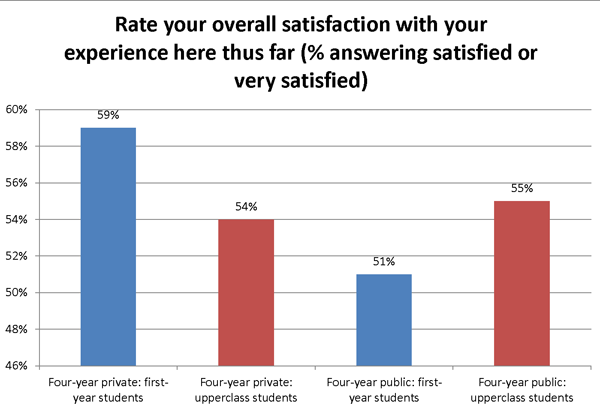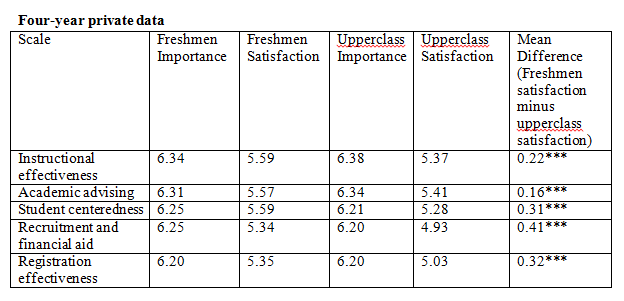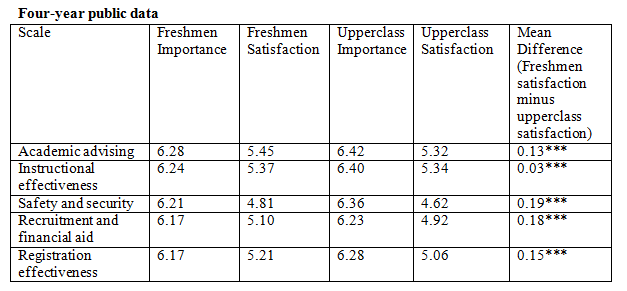enrollment
Tracking college student satisfaction by class at four-year institutions
I recently received inquiries from two campuses using satisfaction-priorities surveys with their students (one a four-year private institution and the other a four-year public university). They noticed that their first-year students were more satisfied than sophomores, juniors, and seniors. Were these results typical of other institutions, or were their data sets unusual? In fact, it has been my general observation that first-year students often reflect higher satisfaction scores, but I took a closer look at the national data sets to confirm that this was the case.
First observation: Overall satisfaction
There is a summary item on the Student Satisfaction Inventory (SSI) that asks students to rate their overall satisfaction levels. This item shows the bottom-line satisfaction perceptions of students in the national data sets. The question uses a 7-point scale (1-not at all satisfied, 7-very satisfied). When we focus on the response of 6 and 7 (satisfied or very satisfied), we get a better idea of students’ perceptions by class level.
Looking at the four-year private and the four-year public data below, we see that each data set tells a slightly different story.

This chart indicates that first-year students are five percentage points more satisfied than their upperclass counterparts at four-year private institutions, while first-year students at four-year public institutions are four percentage points less satisfied than upperclass students at the national level. So the four-year private data supports the general observation regarding first-year students being more satisfied, but we get a different perspective when we look at the four-year public results. What aspects of the student experience could be causing this result at four-year publics? We can dig into the data deeper to investigate.
Second observation: Scale scores
The 73 individual items on the Student Satisfaction Inventory are clustered statistically and conceptually into 12 scale scores which provide the big picture on priorities and satisfaction levels for students. When we review the five most important scale scores, the story shifts again:
Instruction and advising are more important to upperclass students at four-year private institutions, while student centeredness along with the recruitment and financial aid scales have higher importance for first-year students. In all five of these scales, first-year students are significantly more satisfied than upperclass students. This is true for all 12 SSI scales for four-year private students.
At four-year public institutions, all five of these areas are more important to upperclass students, but first-year students are significantly more satisfied in all five categories as well. This is also true for all 12 SSI scales at four-year publics, with upperclass students indicating higher expectations but lower satisfaction. Therefore, when we look at how four-year public institutions are actually serving first-year students, we see that students are more satisfied with the majority of their experiences. There must be a disconnect when first-year students reflect on their overall satisfaction that is reported with the summary score. We need to dig even deeper into the data to see what else we can learn.
Third observation: Item scores
We can also look at the data item by item to identify where first-year students may be significantly more or less satisfied than upperclass students.
At four-year private institutions, first-year students are significantly more satisfied on all 73 standard items on the SSI, with a mean difference range of 0.58 (adequate student parking) down to 0.08 (library staff are helpful). These data reinforce that the first-year students are more satisfied with all aspects of their student experience than upperclassmen at four-year private institutions.
At four-year public institutions, first-year students are significantly more satisfied on 60 out of the 73 items. It is interesting to note where upperclass students are significantly more satisfied and, conversely, first-year students are significantly less satisfied:
While the individual differences may be slight, the cumulative effect on these primarily instructional related items may impact students’ overall perceptions of their satisfaction at four-year public institutions. They may also help to explain that while first-year students are significantly more satisfied with most aspects of their campus experience, the relatively lower satisfaction with faculty access and interactions may contribute to their bottom-line perceptions, and ultimately the lower satisfaction summary score.
Here are three theories on first-year satisfaction and what you can do on your campus in response:
- Campuses typically take very good care of first-year students, with strong orientation programs, first-year experience seminars, and access to key classes so freshmen have a lot of reasons to be satisfied with their colleges and universities. That is great and I say keep up the great work, but be mindful that some of these additional services and attention may be appropriate for your sophomore and junior students as well. (My colleague Tim Culver discussed research studies on the sophomore experience, and Noel-Levitz offers a Second-Year Student Assessment to survey sophomore motivations and keep second-year student on the path to completion.) A potentially valuable resource as you consider the priorities for your institution is a white paper by Dr. Laurie Schreiner that studies the link between satisfaction and retention, with a special focus on suggested responses by class levels. By being more intentional in your services to your upperclass students, you may be able to further improve satisfaction and ultimately the retention of these students.
- Each experience a student has with your institution is an opportunity to meet, exceed, or fail to meet expectations. As first-year students, the number of interactions students have had at college may be limited. Each year, they have more experiences to reflect on and more opportunities to rate your campus lower with their satisfaction scores. How is your institution doing with all of the customer service touch points? Do you have opportunities to further improve your customer service focus and to be especially aware of the policies and procedures that may be in place for sophomores and juniors?
- There is a theory that the longer students are with us, the more comfortable they feel in being honest with us about their experience. (Dr. Schreiner refers to this as the “marriage effect”, where the longer two people are together, the more honest or real they may be with each other as compared to how people may act while they are dating.) It may also be true that first-year students still have the “glow” of the recruitment experience and are feeling good about their college selection. However, as institutions, you may want to be more intentional in re-recruiting students during their second and third years, to remind them why they selected your campus in the first place, and to tell them again what a good decision they made to come to your institution. These positive reinforcement communications keep students feeling good about their college choice, further solidify satisfaction levels, and increase their chances of graduating and becoming your alumni donors of the future.
I encourage you to review your own satisfaction data for your campus to see how your satisfaction levels vary by class level, or other demographic subgroups you identify. If you would like to visit further about the best ways to approach these data or any other satisfaction assessment topic, please feel free to contact me at julie-bryant@noellevitz.com.
Note: The data reported are based on the responses to the Noel-Levitz Student Satisfaction Inventory between the fall of 2008 and the spring of 2011. The four-year private data reflect 253,626 student records from 354 institutions while the four-year public data reflect 81,094 student records from 87 institutions. The first-year students are 32 percent of the four-year private data set and 23 percent of the four-year public data set. The upperclass students are 61 percent for four-year privates and 63 percent of the four-year publics. The remaining students are graduate level students or indicated other class level.
The mean difference asterisks definitions are * = .05; ** = .01 and *** = .001 for statistical significance. The mean difference is the first column satisfaction minus the second column satisfaction.


